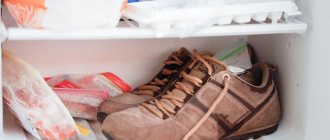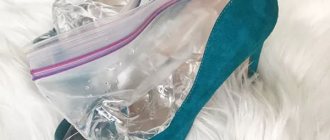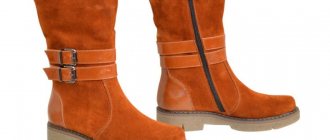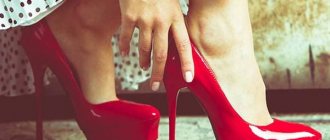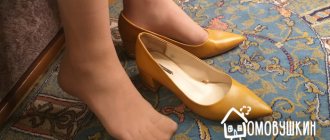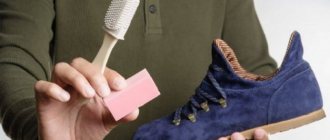Buying shoes is a long and exhausting process. But the real torment begins later, when suddenly the shoes that seemed so soft and comfortable in the fitting room begin to cause discomfort, press or rub your feet on the street. If such a misfortune has happened to you, and the question of what to do if your shoes are too tight has arisen, you should not fall into hysterics or immediately run to the store for new shoes. This problem can be easily eliminated at home, using improvised means.
Why do you have to break in your shoes?
Choosing the right shoes is a top priority. After all, only a high-quality pair that fits well on the foot can be worn comfortably. In the store you need to try on the model you like and walk around a little. If the shoes are too tight and it is uncomfortable to stand and move in heels, then you should refuse the purchase. Shoes usually stretch a little during wear, but this is a minor issue. The noticeable discomfort will not go away. This is why you need to buy shoes in your own size.
But it’s not so rare that even high-quality shoes that fit your feet rub your heels. This happens due to the fact that the material from which it is made is still unworn and hard. Moreover, the problem is relevant for both leather products and textiles. Gradually, the new pair will fit your feet, the back will soften, and you can forget about calluses. To speed up this process and break in shoes or boots, various methods are used.
Shoes may rub due to poor seams. Solving this problem is somewhat more difficult than simply taking apart a purchased pair, but it is still possible.
You can break in shoes using different methods. Thanks to this, the shoes will stop rubbing your heels, and you will be able to cope with the following inconveniences:
- the store did not have the appropriate size and had to take a slightly smaller one;
- the shoes are a little tight in width, but fit well in length, or vice versa;
- shoes become tight in the evening;
- the size changed after the rain (this often happens with suede products).
Why new shoes rub your heel, and what to do to avoid mistakes when buying
There are many reasons for this problem. It is important to know the basics in order to avoid problems when purchasing.
- The size is incorrect.
- The model is not right for you, since everyone has different fullness and width of the foot, as well as a different curvature of the heel.
- The back of the shoe is too hard.
- Poor quality material, rough seams.
- Excessive sweating of the feet.
pixabay
Special means
In some cases, it is enough to wear new shoes at home for an hour or two every day. After a few days, the discomfort will most likely pass. But you can use other methods. For example, many shoe shops offer to stretch leather products using special equipment. If you don’t want to give the shoes to a master, then you should try to correct the situation yourself.
Special stretching agents are sold in stores. They are very easy to use, you just need to follow the instructions. Usually it's a spray. It is applied to the inside of the products, after which they are put on. Most likely, this will have to be repeated several times. To get results faster, you can warm up your shoes with a hairdryer, then apply a similar product and put them on your feet in thick socks.
We recommend: How to wash white sneakers so they look like new?
Also, if a new pair rubs your heel, you can buy a moleskin patch. It is glued both to a callus and to an uncomfortable place on shoes. Special soft strips are also sold that are placed inside to reduce friction. There are also silicone pads that are attached to the heel where the boots cause discomfort.
When the callus is already there
Did you rub your heel with your shoes? What to do, how to treat the leg in such a situation? If calluses or even blisters appear, you should not neglect this. Otherwise, the neglected problem will lead to more serious consequences.
Contrast baths help relieve pain, relieve itching and burning. Warm, cool water will help deal with the problem even faster if you add chamomile, calendula, nettle or burdock to it. All of these plants have antiseptic effects, heal and soothe the damaged area.
After the procedure, you will need to wipe your feet dry and, using a special fatty cream, apply to the rubbed area of skin.
Traditional methods
When the question arises of how to wear a rubbing pair, you don’t have to go to the store. It is quite possible to achieve the desired effect using improvised means.
A hard back will soften faster if it is soaked. It is recommended to use vinegar for leather, and plain water for textiles. When the backdrop becomes wet enough, it must be gently wrinkled. You just need to pay attention that cardboard inserts are often used in textile products. Such influence will not benefit them.
Glycerin has proven itself well for leather items. It is easy to find at the pharmacy and the benefits can be impressive. The processing is carried out in this way. First you need to dip the towel in hot water, then it should be placed in the shoe. When it cools down, the shoes are lubricated with glycerin. Hot water will make the skin more receptive to the product.
Advice
A regular deodorant, roll-on or solid, will help you avoid calluses. You just need to lubricate the inside of your shoes.
If your shoes rub on the heel, you can use regular newspapers. They need to be torn into pieces and wetted generously. Then place it in the problem pair, stuffing the product very tightly, and leave to dry. It is not recommended to put it on the battery; the process should take place naturally.
It is no less convenient to use alcohol. Alcohol or vodka will do; you can even use cologne. You need to lubricate the inner surface, then put the shoes on your feet in warm socks. You need to walk like this for about half an hour. You just need to know that it is better to use beer for products made of fabric or suede. Otherwise, they are processed in the same way as leather ones.
Advice
It is not recommended to apply the product to the outside, as this may spoil the appearance of the shoes. Alcohol can change the condition and color of the material, so you should go outside in the treated steam only after it has completely dried.
Another popular folk method is freezing. Plastic bags should be filled with water and placed into problem items in such a way as to fill the areas that need to be stretched. It is better to take two bags for each boot, without tying the top one. This measure will help avoid an unpleasant situation if one of the packages turns out to be not too strong. The water will expand as it freezes, which will achieve the desired effect. Once the boots are removed from the freezer, it is not recommended to immediately remove the ice. You need to let it thaw a little. The method has proven itself quite well, but in rare cases the shoes crack or creases appear on them.
We recommend: 4 ways to clean suede or velor shoes without a brush
You can try a safer method. It is very simple: you need to thoroughly moisten the towel with water and wrap the box with the purchased pair. A humid microclimate is formed in the box, which helps to quickly soften hard skin. The procedure should be quite long, it is recommended to leave the towel on overnight. You may need to do this several times.
To break in uncomfortable shoes, you can lubricate the inside of them with castor oil. Another option is to lubricate the backdrop with a piece of soap or a candle. Friction will decrease, which means calluses will not appear.
Stretch and wear out
While enjoying a new thing, you shouldn’t put it on and expect to show off in it all day. There will be some discomfort for some time until the material “gets used” to the shape of the foot. If the shoes rub anywhere, we try to stretch them. To do this, we turn to chemical (you can buy them in shoe stores) or mechanical means. But no one can do the fitting better than a shoemaker. He is the one you should contact if possible.
Natural material
If your shoes chafe, you can use several methods. One of them is mechanical in nature. If the backdrop rubs, you need to wrap it well in soft material and tap it with a small hammer, being careful not to spoil the material. You can use pliers instead of a hammer. The option is completely unsuitable for varnish coating.
Regular table vinegar, which is a caustic liquid with the ability to make the material more elastic, will help make your shoes soft. It is necessary to moisten a piece of cloth in it, squeeze it out so that the liquid does not drain, and put it inside the shoes, keeping it there for 12 hours. A more gentle option is a damp cloth. But here you need to use glycerin, lubricating the problematic parts of the model with it. This must be done by waiting a quarter of an hour from the moment a hot, damp piece of cloth is placed inside, allowing the material of the product to warm up sufficiently. Glycerin can be replaced with castor oil. Paraffin, natural wax and soap are also suitable in this status.
How to sell a new model faster? Shoes that rub are pre-treated. To do this, use vodka, which is used to rub the sides and back from the inside. Then we put on socks, put on our shoes and walk indoors until the pair is completely dry. One of the simple ways to prevent new shoes from rubbing your feet. The pair must be the right size.
Important! Shoe stores sell aerosol products for such purposes that are harmless to leather shoes.
Artificial material
Leatherettes and other synthetics require a different approach. If shoes made from such materials rub, vinegar, as in the previous example, should be replaced with alcohol. You should carefully study the composition of the products used. The presence of acid will render your new purchase unusable. If your shoes rub your heel, use a water-alcohol solution prepared in advance. Soak your fingers in it and knead the product in the heel area. Do not apply excessive force and do not use this technique; if the design contains cardboard elements, they will lose their original shape.
All vegetable oils are suitable for use from the inside - rub and leave to soak for 12 hours, followed by wiping off any remaining residue with a napkin. Oil can be replaced with glycerin, it is absorbed faster, after which it will be easier to break in the shoes.
Purchased synthetic shoes rub the skin on the heel. The method involving the use of a damp hot cloth, a hammer or pliers also works, but the risk of damage remains.
Return
If you have no idea how to break in a purchased pair of shoes (or this is not possible), use the return-to-store option. The legislation regulates such a procedure, so there is nothing terrible here if you adhere to certain rules, using your consumer rights:
- a product purchased for a maximum of 14 days before the buyer decided to return it to the seller is subject to return;
- mandatory preservation of the packaging in its original condition and availability of a receipt;
- shoes must be returned in their original condition.
If there are significant defects, the goods may not be accepted legally. If the buyer does not comply with the stipulated standard conditions, the return may also not take place. If the buyer feels that he is right, then he has the opportunity to express his claims in writing to the store owner with a copy sent to the manufacturers or for use in legal proceedings.
If the decision is positive, the buyer will be offered options to get out of the situation: return the entire amount or replace it with a new pair, or with another model with an additional payment, or vice versa, return the difference if the purchase is less expensive.
If your shoes are rubbing because of the seam
Even knowing how to break in uncomfortable shoes, it is not always easy to solve this problem. If the cause of discomfort is a rough seam on the heel, then simply softening the skin will not help. The easiest way is to refuse such a pair, return it or exchange it.
But if you like the shoes and don’t want to part with them or it’s impossible to return them, then there is a way out. You need to go to a shoe shop. Depending on the model and material from which the shoes are made, a specialist will be able to:
- move the seam to the side;
- apply a soft patch.
As a result, the seam will stop rubbing your foot, the discomfort will disappear, and you can safely walk in the shoes. The appearance of the couple will not be affected.
Right choice
To prevent chafing, here are some tips to follow. Otherwise, unnecessary expenses for treatment of calluses cannot be avoided.
- You should not buy shoes just because they are beautiful. Before purchasing, try putting it on and walking around the store for a few minutes.
- The choice should be made in favor of those models that correspond to the size and fullness of the legs. Don’t even try to believe that while wearing the shoes, they will stretch to an acceptable size and become comfortable.
- Even the softest shoes can cause blisters.
- It is best to purchase those models that are made from natural materials and have an orthopedic shoe.
- You can stretch your shoes at home using special lasts.
What to do if calluses appear
It is not always possible to protect your feet from calluses. In this case, it is important to know what to do. If a blister forms, you should never puncture it or remove it in any other way. The fact is that it contains a liquid that is an antiseptic and protects delicate skin from bacteria. Therefore, you must try not to damage it when walking. After some time it will burst on its own. Then it is recommended to crumble two streptocide tablets and treat the wound. This will promote faster healing.
It is also worth using bactericidal patches. Moreover, they are used both for calluses that have already appeared, and for the prevention of their formation. You just need to stick them where the heel is most in contact with the heel. Your feet will be comfortable, and the new pair will soon be broken in.
Knowing what to do if new shoes rub your feet, you can quickly solve this problem. You can use a special tool that will help you break in uncomfortable shoes, or try one of the traditional methods. Leather products are best affected. You just need to be patient and do everything correctly, following the recommendations.
Dealing with the consequences
My shoes rub my heels, what should I do? There are two sides to the problem. In parallel with breaking in, you need to worry about the legs, which have already suffered. It is not always possible to protect yourself from the appearance of calluses in a timely manner. If it has already appeared, then first of all we change the pair to a familiar and comfortable one. And we use it until the wound heals.
Wet blisters
The so-called dropsy is very painful, so the bactericidal patch should protect the neoplasm from exposure. Do not try to pierce it, to avoid the risk of infection. To speed up regeneration processes, use freshly cut aloe or plantain to prepare a compress.
The healing of dropsy is a long process and requires special actions:
- Iodine, brilliant green, peroxide are used for disinfection in the wound area.
- We prepare a bath and disinfect the sewing needle in it for 5 minutes.
- We heat the bubble on several sides to drain the exudate. Punctures are made parallel to the skin.
- There is no need to tear off the skin of the bladder; it will act as protection for the wound during the healing process.
- Apply antibacterial ointment and cover with a bactericidal plaster.
Correctly carried out actions minimize the risk of infection of the wound surface. In the future, the bandage must be changed every 5 hours.
Dry corns
The skin's response to constant pressure is its hardening. Dry calluses appear in such places. They get rid of them with baths and compresses using potassium permanganate and chamomile decoction. The temperature of the prepared solution should be within 40 degrees.
How to prevent calluses
New shoes rub your skin - how to get rid of this problem? Only ideally selected shoes and their correct placement can serve as a guarantee. The correct size and comfortable last is reinforced by gluing a bactericidal patch to critical areas of the foot.
Is it possible to return (change, return) shoes?
You can return purchased shoes to the store if:
- less than 14 days have passed;
- they didn't wear shoes;
- you saved the receipt;
- you discovered a defect.
In the latter case, you may be asked to conduct an independent examination. You must pay for it yourself. If the defect is confirmed, the shoe company will compensate for losses and return money for the goods.
It’s better to carefully choose shoes before purchasing than to worry about what to do with uncomfortable shoes later.
Combating complications
Quite often, bubbles burst on their own due to friction. Such a combination of circumstances is fraught with danger, since infection can easily leak through the wound. Accordingly, you will have to spend money on expensive and lengthy treatment.
A weak solution of potassium permanganate, which is recommended to wash your feet, will help avoid complications. After this, it is necessary to carefully treat the blister using hydrogen peroxide. At night it is worth applying a compress with special ointments.
Shoes rub calluses on the heels - what to do? Instead of ointments, you can use aloe pulp. Plantain or a cotton-gauze bandage pre-moistened in a chamomile solution will help to cope with the problem. All the methods described above help to disinfect the wound and get rid of blisters and chafing.
How to break in tight shoes made of genuine leather at home
Shoes that fit well but are tight in width will stretch well if:
- stuff it tightly with torn wet newspapers, leaving it for a couple of days until it dries (only away from heating appliances and the sun);
- in the evening, pour the cereal inside the shoes and pour hot water to swell - increasing in size, the swollen grain will stretch the tight shoes, in the morning all that remains is to remove the gruel, wipe with a cloth and boldly go about your business;
- at night, rub the inside of the shoes with regular candle paraffin and insert any fabric (socks, towel) into them as tightly as possible; In the morning, taking out the contents, we get a stretched and soft pair.
If necessary, all of the above methods can be repeated or alternated until the desired result is obtained. Practice shows that boots or shoes made of high-quality leather stretch well both in width and length (of course, within reasonable limits).
How to choose the right shoes that won't rub
- Mandatory fitting. Walk around in pairs, take them off and put them on again, make sure that the model does not squeeze your leg, does not dangle, the sole is elastic but durable;
- Evening shopping. Choose models at the end of the working day: if there is swelling, you can buy a pair that will not put too much pressure on your foot in the evening;
- To size. Large or small shoes will cause tired feet, discomfort, and the appearance of calluses;
- Take into account anatomical features. High instep, wide foot, uneven toes;
- Materials. The leather can stretch a little, but only in width, and there are no substitutes;
- For growth. A loose pair rubs more than a narrow pair;
- Measurements. Before shopping, measure the length of your feet; it will be easier to choose a pair in the store;
- Checking seams. Feel the interior space; there should be no rough protrusions or bumps.
It’s better to buy a comfortable pair that won’t chafe and your feet won’t get tired in it, made from natural materials. They stretch more easily and follow the shape of the foot, even if there are features.
The most effective options for stretching leather shoes
There are many interesting methods for stretching tight shoes at home:
- Peel the potatoes, then stuff the inside tightly, leaving for twelve hours;
- Put the pair on your feet, and then warm them up using a hot air stream from a hairdryer;
- Beat the cereal, then pour boiling water into it. After the shoes have been left for one night, remove all residues;
- Use the remaining material after the entire inner surface has been treated with paraffin. This procedure is repeated more than once so that the model becomes the required configuration;
- Place bags filled with water into each shoe and place them in the freezer. This option is not suitable for summer models - the sole may crack.
The heel part can simply be lubricated with soap or alcohol to prevent the heels from chafing. Taking into account the fact that folk remedies require certain skills and dexterity, you can resort to more professional processing with special compounds that are produced for these purposes.
According to the instructions, apply the composition and use a stretcher or simply put it on your feet.
Soften hard soles - shoemaker's advice
The soles of shoes can become hard over time. This is especially true for those products in which it is made of rubber. Walking in such shoes is uncomfortable, but this is a natural process that cannot be stopped. However, there are methods to make the hardened sole much softer:
- The easiest way is heating. To do this, you can use a hair dryer, radiator or clothes dryer. It is also possible to place shoes in the oven for 5-10 minutes with the soles facing up so that they do not stick to the baking sheet. The optimal temperature is 90-100 degrees. This is quite enough; overheating can simply ruin the product;
- If the sole is removable, it is convenient to soften it with a special impregnation. Pour a solution of medical alcohol and wintergreen oil, taken in a 3:1 ratio, into a container prepared in advance. Carry out all procedures wearing gloves to prevent an unpleasant odor from coming from your hands later. Place the product in the solution so that it is completely immersed in the liquid and leave. Softening may take several hours or several days. Then remove the sole and remove excess moisture with a napkin. Despite the strong smell of oil, it is better not to rinse it with water: this will make the material even more pliable over time.
Information. All these methods shorten the life of the product, accelerating its wear. Therefore, before you start softening the rubber sole, make sure that this is really necessary.
How to treat calluses
If shoes rub your heels, calluses appear, what to do: stop wearing this pair, start treating the damaged areas. If the blister has already burst, disinfect it and remove dead skin. It is necessary to cover the wound with a bandage to prevent bacteria from entering the bloodstream.
What to do if your shoes have rubbed and calluses appear, start treating them:
- Talc. The powder absorbs moisture well. The treated foot will glide better, and the problem area with injured skin will no longer be irritated by contact with the pair material. Can also be applied to the insole, sides and heel;
- Moisturizing, softening cream. What to do if the shoes are hard and have rubbed a callus: generously lubricate the area of the foot where the skin comes into contact with the pair. This will help soften the walls of the model and create a friction barrier on the epidermis;
- Aloe vera gel, ointment. A good remedy for the treatment of calluses, a natural antiseptic. Deeply nourishes, moisturizes the affected area, accelerates wound healing;
- Medical Vaseline. If the shoe rubs the heel: apply the greasy composition, rub it in, and allow it to be absorbed. The risk of blisters will be reduced;
- Coconut oil. Moisturizes the skin, applied 2-3 times a day to damaged areas, prevention of calluses.
Flaxseed oil is suitable to soften calluses; rough skin can be removed with a soft scrub.
If you rub your heel in sneakers
Stretcher for sneakers
Chapped heels are a fairly common symptom of recently purchased shoes. In order not to carry around a pack of adhesive plasters to cover abrasions, you need to solve the problem as soon as the problem arises. To do this, you can use the following tips:
- Special silicone stickers on the heels of shoes prevent the appearance of calluses;
- To soften hard heels, use a hammer to lightly tap the back of leather shoes from the inside;
- Place a towel soaked in warm water in the shoes and leave for 20-30 minutes. After this, apply pharmaceutical glycerin to the water-softened backdrops and leave until the morning. If this procedure does not help the first time, it is recommended to repeat it;
- If shoes have been left for a long time without proper care, the leather can dry out and rub the heels. To cope with this problem, you need to lubricate the back with baby cream, fat or soap and leave it overnight;
- If your sneakers are rubbing at the back due to the seam running along the heel, you should contact a shoe repair shop. The master will install a patch made of soft material in this place. In addition, the workshop offers a service for stretching shoes to length, which will also help achieve wearing comfort.
If you need to purchase stretching products, follow the link to the Lamoda website .
Where to buy quality shoes
If you are interested in the latest men's and women's shoes from Italy, take a look at our Vivendi store. Here you will find models from more than forty Italian designers. The presented assortment will allow you to get acquainted with the latest trends in both women's and men's shoe fashion.
Our advantages:
- DELIVERY IS FREE! Delivery to any region of Russia is free upon purchase of more than 20,000 rubles.
- PRICES ARE BELOW MARKET AVERAGE. Thanks to direct deliveries from manufacturers, we offer shoes with a minimal margin. In addition, the store regularly holds sales and has a system of discounts.
- QUALITY AND AUTHENTICITY GUARANTEED. We deliver shoes from Italy ourselves, and therefore we are 100% confident in their quality.
- CHAIN STORE IN MOSCOW. If you need to evaluate the look and quality of shoes with your own eyes, visit one of our stores.
- CONVENIENCE OF PAYMENT. Cash and non-cash payments, bank cards and electronic currency - you choose the most convenient payment method. A reliable system for protecting user data makes the purchase safe.
- DELIVERY IN SEVERAL SIZES FOR TRYING ON. Order several sizes and models for delivery at once and choose the most convenient one.



